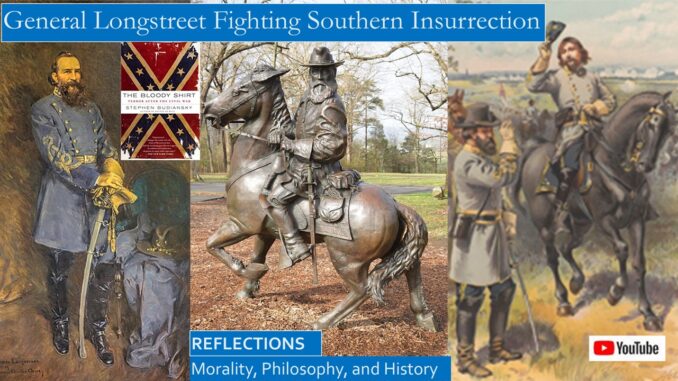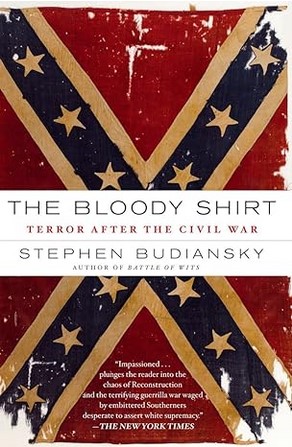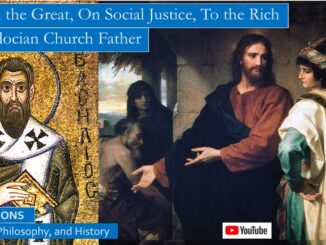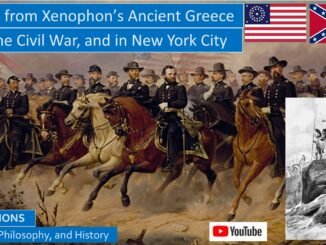
What can we learn by reflecting on the remarkable stories of how the former Confederate General Longstreet and the Union Major Merrill valiantly attempted to enforce the civil rights legislation during the Reconstruction Era? How were they able to protect the newly freed blacks from the terrorism of the Ku Klux Klan and other white supremacist terrorist groups?
Why did the murderous KKK have such broad support among whites in the South, and also among white Christians?
We reflected on the story in the book, Bloody Shirt, Terror After the Civil War, to answer a very personal question, How can so many of my Christian friends seem to embrace the false narratives of Fox News and Donald Trump, valuing cruelty over compassion? What are so many white Christians so against what they call WOKENESS, against the Black Lives Matter ethos, against Civil Rights, against basic kindness?
Script for this video, with more Amazon book links: https://www.slideshare.net/BruceStrom1/chaos-of-reconstruction-terror-after-the-civil-war
YouTube: Terror During Reconstruction, White League Confronts General Longstreet and Union Army: https://youtu.be/bF3w2RrSaM0
Major Merrill showed considerable bravery both in his actions during the Civil War and in his first posting enforcing the Reconstruction Amendments in South Carolina after the war.
GENERAL LONGSTREET AND MAJOR MERRILL
We will tell the stories of General Longstreet and the Union Major Merrill. General James Longstreet, a former Confederate general who had become a pariah in the South when he changed his party affiliation to Lincoln’s Republican Party, tried to prevent the insurrection in New Orleans. For his second posting during Reconstruction, Major Merrill attempted to reverse the insurrection of parishes on the outskirts of New Orleans.
What was James Longstreet like? Our author, Stephen Budiansky, described him as a “messy bear of a man, six foot two with unkempt beard and a big hairy chest,” “born in South Carolina though reared in backwoods Alabama. He could ride a horse better than” anyone. “He was the best fence jumper in the whole Confederate Army.”
During the Civil War General Longstreet was seen as a Confederate war hero and one of Robert E Lee’s most dependable generals. Our author writes that Lieutenant General “Longstreet was Lee’s senior corps commander and his stalwart companion in battle. Lee always pitched his tent near Longstreet’s and enjoyed his good humor and sociable instincts; Longstreet gave advice, and Lee listened, even if he often didn’t take it. Lee called him his ‘old war horse.’” The affection was mutual, “Longstreet named his son Robert Lee Longstreet.”
Our author writes that General “Longstreet learned the hard way what most of his fellow commanders, North and South, never did, that by standing on the defensive an outnumbered force could let its attacker bash himself to pieces first, and then could chew the pieces into mincemeat with a well-timed counterattack.” General Longstreet strongly offered this unheeded advice during the Battle of Gettysburg when he warned General Lee that a frontal charge against Union forces was suicide, and fifteen thousand rebels died marching into a volley of artillery and bullets in the fatal Pickett’s charge. Longstreet and Pickett both reluctantly followed orders and did the best they could, and General Lee would ride among his men in the aftermath, apologizing to his men that it was all his fault, that he was the one responsible for this horrible decision.
After the Civil War, after General Longstreet joined the Republican Party, after he became a Union general opposing the Ku Klux Klan, he was blamed by many in the South for the disaster of Pickett’s Charge, he was blamed for losing the Civil War for the South. The Southern revisionists even tried to rob Longstreet of his close friendship with Robert E Lee.
When the Confederate forces were surrounded and cut off from their supplies after the Battle of Appomattox, James Longstreet advised Robert E Lee that he thought General Grant would offer fair terms if he surrendered. Soon after the war, a grand jury indicted Generals Lee and Longstreet and other Confederate officials for treason, a crime punishable by hanging. General Grant objected and rode to the White House, threatening to resign if charges were not dropped, as he saw it as breaking the parole and surrender terms signed at Appomattox. President Andrew Johnson backed down, and charges were dropped.
In 1867 the editor of the New Orleans Times invited prominent Confederate leaders to share their views on the Reconstruction Amendments and acts of Congress. Our author paraphrases Longstreet, “the South had fought, and fought well, but had lost; they were a conquered people, their duty was to accept the terms of the victor.”
General Longstreet wrote: “The surrender of the Confederate armies in 1865 involved:
- The surrender of the CLAIM to the right of secession.
- The surrender of the former political relations of the negro.
- The surrender of the Southern Confederacy.”
“The political questions of the war should have been buried upon the fields last occupied by the Southern armies.” One of the gravest errors was the opinion that “we cannot do wrong, and that Northerners cannot do right.” When he made it known that he was endorsing Lincoln’s Republican Party, his former friends and acquaintances shunned him and his family.[1]
INSURRECTION AT NEW ORLEANS
Our author writes that “on a late summer day in 1874, General Longstreet rode his horse through the silent French Quarter and could see the barricades in the streets beyond. Every wall he passed was plastered with the placards that had suddenly sprung up across the city,” which read: “CITIZENS OF NEW ORLEANS: For nearly two years you have been the silent but indignant sufferers of outrage after outrage heaped upon you by a usurping government. On Monday the 14th of September, close your places of business” at 11 AM “and assemble at the Henry Clay statue on Canal Street.”
Our author continues, “Five thousand citizens responded to the call that morning in New Orleans; doctors, bankers, lawyers, journeymen, clerks, and laborers, all gathering there at the foot of the statue of Henry Clay.”
Confronting this heavily armed mob, and they were armed, many of them Confederate war veterans, were “five hundred white and colored troops of the Metropolitan Brigade.” They advanced “past shuttered shops, bringing a Gatling gun, two twelve-pound brass cannons, and four smaller artillery pieces with them. General Longstreet was violating one of his oldest principles of battle: he was taking the offensive against a superior force.”
Initially there was a stand-off between the two forces, the rebels piled up more barricades in the street. The White Leaguers demanded that the rightful winner of the election was the segregationist Democratic candidate, they wanted to overthrow the Lincoln Republican regime. Our author writes, “at around two o’clock a detachment of the White Leaguers marched over to City Hall and demanded the immediate surrender of the building from the mayor.” “The governor then told his militia commander that it was time to take action and wait no more. So, Longstreet had reluctantly ordered the change in plan from defense to offense.”
The federal troops opened up with the Gatling gun, cannon, and artillery, for fifteen minutes all guns were blazing from both sides. Thirty-one men lay dead on the streets, mostly White Leaguers, and over a hundred were wounded, including Longstreet, who was slightly injured. It was with difficultly that the White League leaders dissuaded their followers from aiming at General Longstreet, which could have escalated the fighting.
That night Longstreet reviewed the stores of ammunition, he was running low. This compelled him to surrender the State House the next morning, he went home and was in bed for six months with a severe illness.
The next morning the train pulled into New Orleans with two passengers, the segregationist Democratic candidate who had lost the governor’s race, John McEnery, and the area’s commanding general of the United States, William Emory. Our author writes, “these two men met formally. General Emory read a proclamation from President Grant. He ordered those who had combined together with force of arms to overthrow the state government of Louisiana to disperse.”
“McEnery denied there had been an ‘insurrection’ and protested this act of military interference in state affairs, but said he had no desire to resist the armed force of the United States and would order his ‘state troops’ home and turn over the State House, but only to the Army.” He was placated with a staged ceremony of surrender, a few days later reinforcements of eight hundred federal troops arrived, and the Lincoln Republican government was restored. But the insurrection was not quickly reversed in all the parishes surrounding New Orleans.[2]
MAJOR MERRILL IS POSTED IN LOUISIANA
Soon after Major Merrill is posted in Louisiana, his dispatches to his superiors again voice his frustration in his inability to enforce even the minimum of a sense of justice for the colored man. When the state government was overthrown by the White League in New Orleans, whites in the surrounding parishes followed suit.
Major Merrill writes his superiors, “the legal mayor of the town had practically abdicated, and his duties were being discharged by another man. The local police had been disbanded, and its place supplied by a volunteer force, consisting of white citizens, many of whom are no doubt good men, but all are partisans of the so-called white man’s party, and a very large proportion” belong to the violent “White League. No civil process of any kind emanating from State authority can be issued or enforced,” as legal officers had been forced to quit. When blacks or whites try to organize political meetings opposing the regime, these are broken up by the White League.
By this time the Union Army was arresting White League terrorists under the Enforcement Acts, not even bothering to go through the local courts. In one town, one of three men arrested was the mayor, and angry crowd gathered and threatened to go after the troops. A few days later, a posse of several hundred men arrived with arrest warrants for two Union officers for a bogus contempt of court charge. Both the posse and the troops then departed for the courthouse in Vienna.
Major Merrill sent telegrams to his superiors and everyone who could assist in having these cases transferred to federal court. Our author writes that “Merrill wanted no display of military force; he wanted to assert the law and set a clear precedent to discourage the White Leaguers for pulling such tricks again. The law was clear: officials acting under the Enforcement Acts could not be arrested by state authorities, they had an absolute right to have habeas corpus cases transferred to federal jurisdiction.”
A few days later Major Merrill learned that the court had quickly found the Union officers guilty and had sentenced them to ten days in jail and a hundred dollar fine. After a flurry of insistent telegrams, the court reversed its decision, freeing the Union officers. Later investigation revealed that the whole proceedings had been concocted by a White League lawyer who was conspiring with the local judge. Just as in South Carolina, he learned that White Leaguers in Shreveport were reading his telegrams, everyone in town was in on the conspiracies.
An army colonel, Henry Morrow, was then sent from New Orleans to report on what was happening under Major Merrill’s watch. Our author writes, “Morrow talked to the white people and concluded that there was no need for more troops and said it was unfortunate that the army was stirring up such resentment by assisting in carrying out such unpopular arrests; he recommended it cease doing so. He did not talk to any colored people since he thought ‘the negro does not comprehend politics.’ He concluded, ‘The present State government cannot maintain itself in power a single hour without the protection of Federal troops.’”
Major Merrill departed to New Orleans by steamboat to testify to a Congressional Investigating Committee. He informed them that over two hundred men has told him that they had been fired from their jobs for voting for candidates from Lincoln’s Republican Party. He said that his life had been threatened, but he thought the White Leagues would not assassinate a federal officers. But they then asked:
Question: Suppose you were to resign your commission and take off your uniform and go back to live there?
Answer by Major Merrill: “I should want to borrow a Gatling gun, at least.”[3]
CONCLUSION
There are ominous similarities between the insurrection in New Orleans and the recent January 6th insurrection at the Capitol when Trump lost the election. The core reason for both insurrections was that the wrong party won the election, and many felt that meant the election was not valid.
What was disheartening was the stubbornness of the former Confederates in Louisiana and other Southern states, they eventually wore down the Lincoln Republicans and seized control of the government soon after when all federal troops were withdrawn from the South after the Presidential Election of 1876, after which they denied the vote to most blacks. Since the Republicans today are trying to deny the vote and due process to blacks, don’t think this history cannot repeat itself.
We also have recorded a video comparing the Big Lie that ignited the January 6th Capitol riots to the lie by the ancient Greek playwright Aristophanes that was a factor in the unjust trial and execution of Socrates.
We puzzle over the wisdom of a son bringing charges against his own father for killing a slave in the Platonic dialogue Euthyphro, comparing it to a son who turned in his own father for participating in the Capitol riots, then talking about it repeatedly on national television.
And also videos on the over ten thousand lynchings that occurred in America during the Jim Crow era,
We review the similarities between Hannah Arendt’s reporting of the trial of Adolph Eichmann, the Nazi bureaucrat who administered the Nazi death camps, to Martin Luther King’s Letter from a Birmingham Jail, which views the black lynching and segregation experience to the Nazi Holocaust and Race Laws.
[1] Steven Budiansky, The Bloody Shirt, Terror After the Civil War, Chapter 18, pp. 149-157 and https://en.wikipedia.org/wiki/James_Longstreet
[2] Steven Budiansky, The Bloody Shirt, Chapter 19, pp. 158-164.
[3] Steven Budiansky, The Bloody Shirt, Chapter 21, pp. 168-176.





3 Trackbacks / Pingbacks